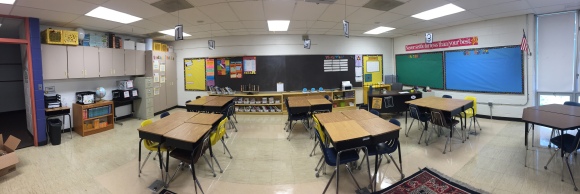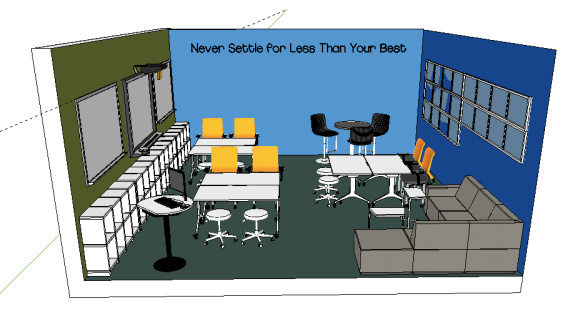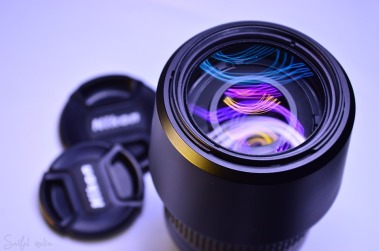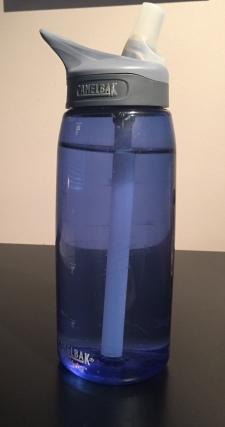By following Berger’s flow of questioning, I can rethink how I want my classroom to look (2014).
Why does my classroom need to be redesigned?
Empathize: Room 105 needs a makeover. Although the construction is being done at Hillel Day School, this is what I want my classroom to look like. Right now, it’s a box. It’s boring, the space feels contained, it’s dull and outdated. There is a chalkboard. This isn’t the 90’s any more, we can upgrade. When moving into my classroom, I made it bright and colorful to look visually appealing to my students. But I wonder if my students would have been more successful in a redesigned space. Define: My classroom is small and I don’t have enough money to make changes myself. I want to create a space allowing creativity and idea generation. But how can I create this environment that can please my administration while allowing my students to coexist with one another as different learners?
Define: My classroom is small and I don’t have enough money to make changes myself. I want to create a space allowing creativity and idea generation. But how can I create this environment that can please my administration while allowing my students to coexist with one another as different learners?
According to Barrett, Zhang, Moffat and Kobbacy, students perform better based on multiple factors including color, choice, complexity, flexibility, connection, and light (2013). I have to redesign my classroom with these factors in mind.
What if I take away standard desks and create flexible seating?
Ideate: What do my students need? They need to be able to move around and be comfortable in the classroom. To learn best, they need the flexibility and choice of modular seating. I want wheels.
“Allow students time and space to choose what they want to do — their choices will illuminate their individual strengths” (Mau, O’Donnell, Wicklund, Pigozzi, Peterson 2010). This reflects the concept of multiple intelligences by Howard Gardner. Giving students the choice, I can expand their creativity and collaboration in addition to letting them grow and feel comfortable.
Changing the way the room is set up allows for a sense of veja du. This concept spoken about by Punya Mishra makes the familiar seem strange (2008). My students and I know this classroom, but when it is transformed they won’t feel the same way. I want to remix the space and make it a more successful learning environment.
How can I make this happen?
Prototype: If I had the unlimited budget and ability to transform my classroom this is what it would look like as designed on SketchUp.
The walls and floor are painted with warm colors just as Barrett, Zhang, Moffat and Kobbacy suggested (2013). I have two dry erase boards on either side of the SmartBoard. I added cubbies to serve as storage for both myself and my students. Underneath the quote is a painted dry erase wall. The other wall is filled with windows allowing natural light to shine through.
I chose to have multiple options for students’ seating arrangements. There are three pods with stools and chairs. These are all on wheels to accommodate for students who need to wiggle and give me the ability to rearrange the tables. By having this option, students can work individually or in groups without the hassle of dragging a desk across the room. I have chosen to also have a high top table where students can sit or stand. In addition, there is a couch with small tables for a laptop or paperwork. These different seating options can be comfortable for all students as they get the choice to decide where they work best.
Click here to view a 3D model of my redesigned classroom.
Test: My vision for the new classroom might not be successful. But testing it out in phases can give me the knowledge to decide if it will work. I can bring in new types of chairs for kids to sit in and bring in a high top table. Students can play around through trial and error to see where they are most successful.
Right now, the space I have redesigned is small and might not be able to accommodate my big visions. Another implication is I might miss more open space for students to gather and move more fluidly throughout the room. If I were able to expand the space, I would feel more comfortable teaching here.
I want my students to have the flexibility to make connections with one another. By having the opportunity to redesign my classroom, I have seen how there are many factors to consider and each detail can make all the difference.
How would you redesign your classroom?
Berger, W. (2014). A more beautiful question: The power of inquiry to spark breakthrough ideas. New York, NY: Bloomsbury.
Barrett, P., Zhang, Y., Moffat, J., & Kobbacy, K. (2013). A holistic, multi-level analysis identifying the impact of classroom design on on pupils’ learning. Building and Environment, 59, 678-689. doi: http://dx.doi.org/10.1016/j.buildenv.2012.09.016
Mau, B., O’Donnell, Wicklund, Pigozzi, & Peterson. (2010). The third teacher: 79 ways you can use design to transform teaching & learning. New York: Abrams.
Mishra, P. (2008, August 4). Véjà du for the first time ever! Retrieved from http://punya.educ.msu.edu/2008/08/04/veja-du-for-the-first-time-ever/


 Zooming in or out can give us a new, fresh perspective. For most of us, our days are spent in the same way. Waking up, eating breakfast, going to work, coming home for dinner, spending time with family and then going to sleep. This cycle may repeat day after day. But what happens when you take a step back and look at those repeated day to day activities from a new point of view.
Zooming in or out can give us a new, fresh perspective. For most of us, our days are spent in the same way. Waking up, eating breakfast, going to work, coming home for dinner, spending time with family and then going to sleep. This cycle may repeat day after day. But what happens when you take a step back and look at those repeated day to day activities from a new point of view.
 During the Explorers unit this year, my 5th graders had a passport. We did different activities to research specific explorers, we created a scavenger hunt around the school and looked at things from a new perspective. One of the activities was to draw the object I had chosen from their point of view and write what they saw. My students thought this was absurd. For 10 minutes, they had to look at my Camelbak waterbottle. But when the timer went off, each 5th grader noticed something different. Those students know I don’t go anywhere in the school without that water bottle; they know it’s dark blue and they know it’s a Camelbak. But they didn’t realize the details because they never had to.
During the Explorers unit this year, my 5th graders had a passport. We did different activities to research specific explorers, we created a scavenger hunt around the school and looked at things from a new perspective. One of the activities was to draw the object I had chosen from their point of view and write what they saw. My students thought this was absurd. For 10 minutes, they had to look at my Camelbak waterbottle. But when the timer went off, each 5th grader noticed something different. Those students know I don’t go anywhere in the school without that water bottle; they know it’s dark blue and they know it’s a Camelbak. But they didn’t realize the details because they never had to.